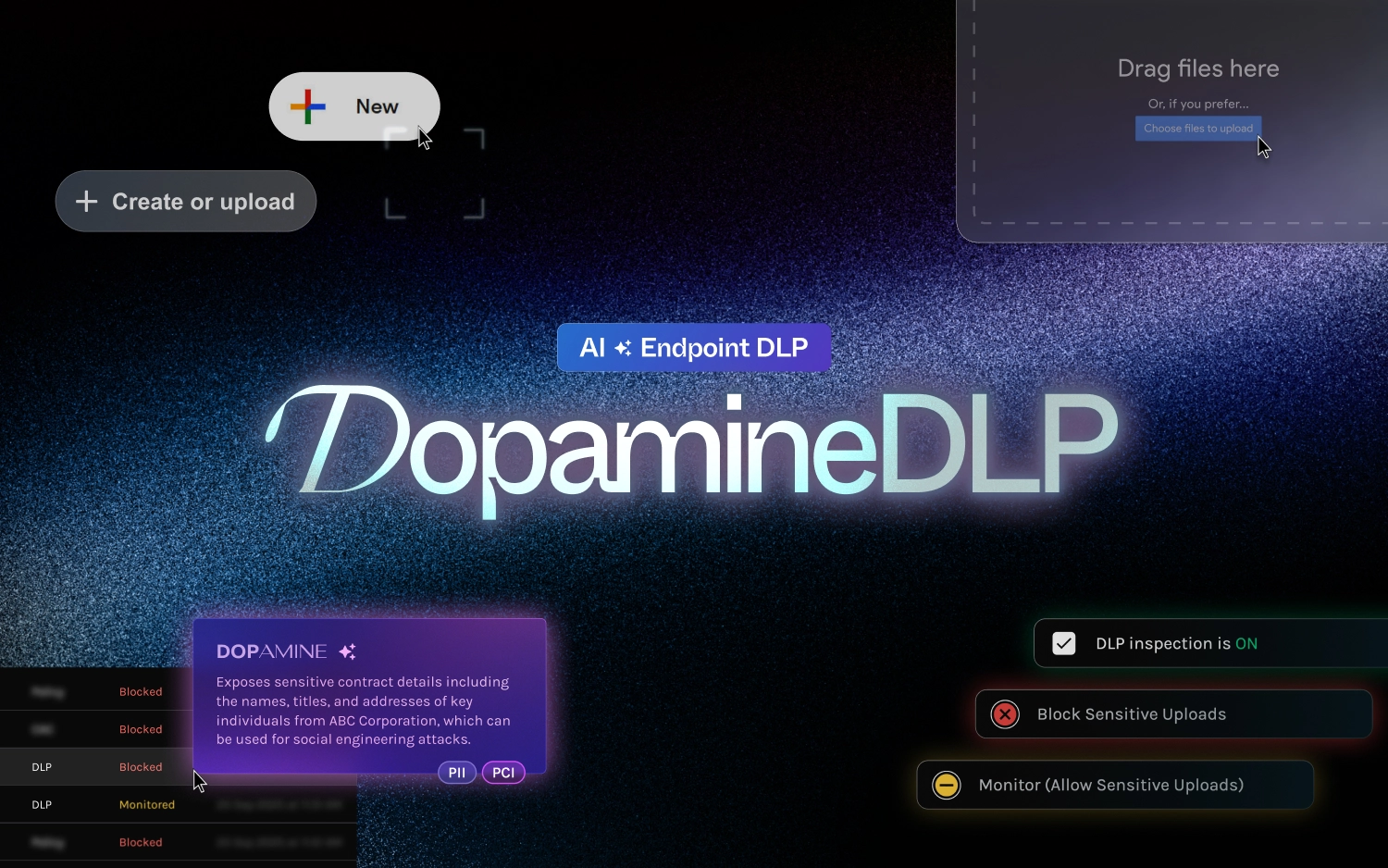Rip & replace legacy DLP: Meet DopamineDLP–AI Powered Data Loss Prevention

AI-powered Endpoint DLP that actually replaces legacy DLP
The problem with “old school” DLP (and why teams quietly turn it off)
Legacy DLP was built for another era. It skims files for patterns, like a 16-digit number “must be a credit card”, and flags anything that looks close. That means your team gets buried under alerts for false positives, misses real risk hiding in context, and spends months duct-taping policy exceptions just to keep people working.
Meanwhile, the web, Google Drive, OneDrive, Box, Slack, ChatGPT, “just upload it to…” apps, are where data actually moves in 2025. If your DLP can’t understand what’s inside a file or keep pace without rerouting traffic through fragile cloud proxies, it becomes shelfware.
What is DopamineDLP?
DopamineDLP is an AI-powered endpoint DLP built right into dope.security’s Fly-Direct SWG agent. Instead of guessing with regex, it uses large language models (LLMs) to understand the content of files during upload and decide whether they contain sensitive data fast, accurately, and without you babysitting rules forever. You can run it in Monitor or Block mode to fit your appetite for enforcement.
DopamineDLP focuses on data in motion on the web channel–uploads to file or media storage apps from corporate devices–because that’s the top leak path for modern companies. This clarity keeps the setup simple and the impact high.
How it DopamineDLP works
Think of DopamineDLP like a smart bouncer at the jet bridge of your flight—not at some distant checkpoint. It sits on the device, notices when someone tries to upload a file to a web app, quickly reads the text inside, and asks a secure cloud classifier one simple question: “Is this sensitive?” The classifier returns Yes/No, and the endpoint enforces your policy instantly with no backhauls, no detours, no guessing.
Here’s the flow:
- Detect: The endpoint sees an upload to a file or media storage web app.
- Extract: It pulls text from the file being uploaded.
- Classify: It sends that text to the Dope Cloud for a binary Sensitive / Not Sensitive decision (powered by LLMs with zero data retention)
- Enforce: Based on your policy—Off, Monitor, or Block—the endpoint allows and logs, or blocks the upload (and logs).
- Record: Each event becomes a DLP violation in the analytics so you can see what happened, where, and why.
Because classification understands context (not just patterns), you get fewer false positives and clearer signals on what’s truly risky—PII, PCI, PHI, or intellectual property.
Built to replace the legacy DLP
- Endpoint-native = fewer moving parts. With the Fly-Direct SWG, policy enforcement happens on the device itself. You’re not hairpinning traffic through overloaded datacenters or bolting on new agents just to inspect a single upload. Fewer components = fewer tickets, fewer surprises, and faster decisions.
- Understands content, not just patterns. Regex thinks in symbols and patterns while DopamineDLP thinks in meaning and context. That’s why it dramatically reduces alert fatigue without blinding you to real leaks.
- Admin-friendly from day one. With a single DLP section in your SWG policy, you choose Off/Monitor/Block and move on. You get clear defaults, intuitive exceptions, and analytics that help you tune your permissions.
Policy that reads like English
Inside the SWG policy, you’ll find a DLP section with three modes:
- Off = No inspection.
- Monitor = Allow the upload; log it as a DLP violation.
- Block = Stop the upload; log it as a DLP violation.
You can override the global mode for specific users or groups, and you can inherit settings from a base policy with the option to reset later. This makes it easy to pilot in Monitor for a department, then roll out Block when you’re confident.
Bypass controls to keep life smooth:
- A DLP Domain/URL Bypass List (with wildcards, comments, and timestamps) gives you quick, auditable exclusions.
- A Dope-managed bypass list (not visible/editable) keeps well-known, safe destinations from wasting your cycles.
- Cloud App Controls (CAC) for Microsoft 365 / Google: domains covered there automatically bypass DLP inspection. OIDC-accepted domains can be excluded as well.
What you’ll see in the console
When an upload trips DLP, you’ll spot it as:
Open the details and you’ll find:
- A DLP-specific violation type,
- The classification (IP, PII, PCI, PHI), and
- A concise Dopamine AI summary explaining why it was flagged, so you don’t have to decode a pile of regex hits.
For audit purposes, every DLP policy change is captured in the Audit Log with who changed what and when. In Analytics, you can track violations by classification type to see whether risk is dropping as you move from Monitor to Block.
Ready to retire your regex?
Legacy DLP had its day. But if your goal is to replace it, not add another console, DopamineDLP gives you the accuracy to block when it matters and the simplicity to roll out quickly. Turn it on, watch the noise drop, and finally get a DLP program your admins can actually live with and use.











